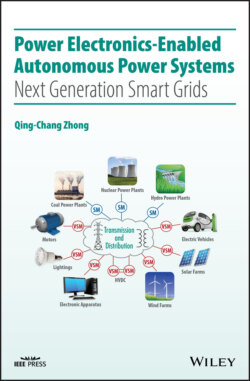Читать книгу Power Electronics-Enabled Autonomous Power Systems - Qing-Chang Zhong - Страница 29
2.4.2 Overall Architecture
ОглавлениеAs is well known, what makes a grid smart is the introduction of an ICT system to the electrical system of a power system. However, any unnecessary or improper use of ICT systems may lead to serious concerns on, e.g. cyber security and reliability, because cyber‐attacks could be launched by anybody, at any time, from anywhere. This is a systemic flaw of the current‐generation smart grid. Needless to say, the electrical system is primary and the ICT system is secondary. The electrical system is the foundation for providing electrical services while the role of the ICT system is to offer added value without causing additional problems. The electrical system should be able to work without the ICT system. Otherwise, the interdependence of electrical and ICT systems may open the door to unknown problems. In a SYNDEM grid, all SMs and VSMs have the same synchronization mechanism so there is no need to rely on an additional communication network for low‐level control and system regulation. Figure 2.5(b) illustrates the overall SYNDEM grid architecture, with the electrical system at the low level and the ICT system at the high level. It has clarified the relationship of the ICT system and the electrical system: various data from the electrical system can be passed on to the ICT system as indicated by the solid arrow but the instructions from the ICT system may or may not be passed to the electrical system as indicated by the dashed arrow, depending on the required level of security. The ICT system can be released from low‐level control to focus on high‐level functions, such as SCADA and market operations.
It is pertinent to clarify the unidirectional role of the ICT system in a SYNDEM smart grid and decouple it from the low‐level or local control of devices and equipment because the SYNDEM smart grid architecture inherently empowers all players to actively take part in the regulation of the grid. Each device or equipment is able to operate autonomously without relying on external communication, while having the capability to receive reference set‐points and instructions if needed. This significantly reduces the need for a high‐speed communication infrastructure and mitigates the concern of cyber security. The ICT system is no longer essential for the basic operation of the electrical system. Even if the ICT system at the high level is not working, the electrical system at the low level is able to operate and provide basic services autonomously. This provides the foundation to achieve cyberattack‐free, autonomous, renewable electric (CARE) power systems and completely solves the systemic flaw of power systems with regarding to cyber security.
The focus of this book is on the SYNDEM electrical system. For ICT systems, see e.g., (Ye et al. 2017).
